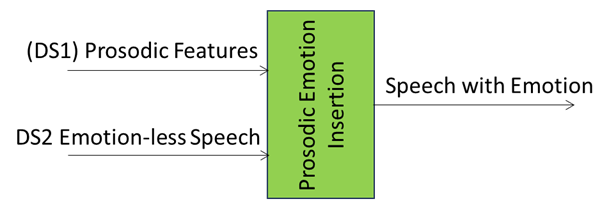| 1. Functions | 2. Reference Model | 3. Input/Output Data |
| 4. JSON Metadata | 5. SubAIMs | 6. Profiles |
| 7. Reference Software | 8. Conformance Testing | 9. Performance Assessment |
1 Functions
Prosodic Emotion Insertion (CAE-PEI)
| Receives | Prosodic Speech Features |
| Emotionless Speech | |
| Integrates | (Emotional) Prosodic Speech Features with those of the Emotionless Speech input. |
| Produces | Emotionally modified utterance Speech with Emotion |
2 Reference Model
Figure 1 depicts the Prosodic Emotion Insertion (CAE-PEI) AIM

Figure 1 – Reference Model of Prosodic Emotion Insertion (CAE-PEI) AIM
3 Input/Output Data
Table 1 provides the Input/Output Data of the Prosodic Emotion Insertion (CAE-PEI) AIM
Table 1 – Input/Output Data of the Prosodic Emotion Insertion (CAE-PEI) AIM
| Input data | Semantics |
| Prosodic Speech Features | Speech Features from Speech Feature Analyser 1. |
| Emotionless Speech | The speech without emotion to which Emotion is added. |
| Output data | Semantics |
| Speech with Emotion | The Emotionless Speech to which emotion has been added |
4 JSON Metadata
https://schemas.mpai.community/CAE1/V2.4/AIMs/ProsodicEmotionInsertion.json
5 SubAIMs
No SubAIMs.
6 Profiles
No Profiles
7 Reference Software
Reference Software not available.
8 Conformance Testing
| Receives | Prosodic Speech Features | Shall validate against the Speech Features schema. |
| Emotionless Speech | Shall validate against the Speech Object schema. The Qualifier shall validate against the Speech Qualifier schema. The values of any Sub-Type, Format, and Attribute of the Qualifier shall correspond with the Sub-Type, Format, and Attributes of the Speech Object Qualifier schema. |
|
| Produces | Speech with Emotion | Shall validate against the Speech Object schema. |
9 Performance Assessment
Table 9 gives the Emotion Enhanced Speech (EES) Prosodic Emotion Insertion Means and how they are used.
Table 9 – AIM Means and use of Emotion Enhanced Speech (EES) Prosodic Emotion Insertion (AIM2 in Figure 3)
| Means | Actions |
| Conformance Testing Dataset | DS1: a dataset of at least x > M Emotionless Speeches. DS2: a dataset of x Speech Features 1, each corresponding to a specific Emotionless Speech. |
| Procedure | For each of the x input pairs of DS1 and DS2:
5. Compute the Average of:
Then, compute the Average for each of the three properties among the n Model Utterances. |
| Evaluation | 1. Condition 3 shall be respected.
2. Given the three Averages computed at the end of the Procedure and denoting them with , where p represents one among the three properties (pitch, intensity and duration), if:
the Neural Emotion Insertion module under test has passed the Conformance Test. 3. Otherwise, the submitter of Emotion Inserter 1 is given the opportunity to submit an implementation of Speech Feature Analyser 1. 4. The MPAI Store will test the combination of the two submitted AIMs. 5. If the quality of the output of the submitted combination of AIM1 and AIM2 is above threshold, Emotion Inserter 1 passes the Conformance Test as long as the corresponding Speech Feature Analyser 1 is made available to the MPAI Store. 6. Else, Emotion Inserter 1 does not pass the Conformance Test. |

Figure 4 – EES Prosodic Emotion Insertion
After the Tests, Conformance Tester shall fill out Table 10.
Table 10 – Conformance Testing form of Emotion Enhanced Speech (EES) Prosodic Emotion Insertion
| Conformance Tester ID | Unique Conformance Tester Identifier assigned by MPAI | ||||||||||||||||||||
| Standard, Use Case ID and Version | Standard ID and Use Case ID, Version and Profile of the standard in the form “CAE:EES:V:P”. | ||||||||||||||||||||
| Name of AIM | Prosodic Emotion Insertion | ||||||||||||||||||||
| Implementer ID | Unique Implementer Identifier assigned by MPAI Store. | ||||||||||||||||||||
| AIM Implementation Version | Unique Implementation Identifier assigned by Implementer. | ||||||||||||||||||||
| Neural Network Version* | Unique Neural Network Identifier assigned by Implementer. | ||||||||||||||||||||
| Identifier of Conformance Testing Dataset | Unique Dataset Identifier assigned by MPAI Store. | ||||||||||||||||||||
| Test ID | Unique Test Identifier assigned by Conformance Tester. | ||||||||||||||||||||
| Actual output | Actual output provided as a matrix of n+1 rows containing all computed Average values:
Result: Threshold: m Final evaluation: Passed / Not passed |
||||||||||||||||||||
| Execution time* | Duration of test execution. | ||||||||||||||||||||
| Test comment* | |||||||||||||||||||||
| Test Date | yyyy/mm/dd. |
* Optional field

